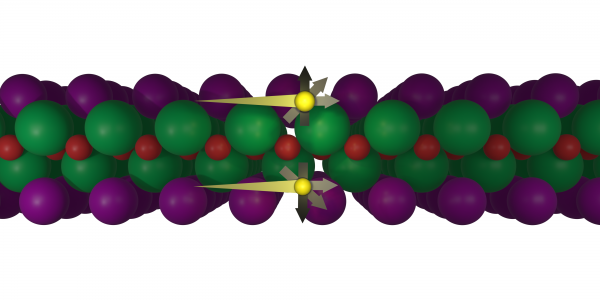Newly identified R-2 2D material may show promise in development of spin-layer-locking spinFETs
by Carey Sargent, EPFL, NCCR MARVEL
The idea for a field-effect transistor based on the electron spin (spinFET) was first introduced in 1990, when researchers Supriyo Datta and Biswajit Das, then of Purdue University, proposed a new device that could potentially operate at low power and provide high computing speed.
Their proposed device was built around a two-dimensional electron gas displaying a particular characteristic known as the Rashba effect. In materials with this feature, the presence of an electric field perpendicular to a 2D conductor subjects the electrons to a magnetic field. The electron spins interact with this field, leading to momentum dependence. This effect can also be seen in narrow-gap semiconductors, like InGaAs/InAlAs heterostructures or in two-dimensional (2D) materials placed between ferromagnetic contacts and under an electrical gate.
Recent research has suggested that a very specific family of 2D materials, named “R-2" and characterized by peculiar local crystalline symmetries, might be particularly suited for the development of spintronic devices, specifically spinFETs. Such materials are made up of two sublayers in which the spin of travelling electrons rotate around an axis in opposite directions because of the Rashba effect. The spinFET can then be built by sandwiching these R-2 2D materials between electric gates to control the spin population of each sublayer, and therefore the rotation of the spins travelling through the material.

LuIO, a promising spintronic 2D material found in MARVEL’s portfolio, is made of two sublayers with strong and opposite Rashba effects. The spin of electrons travelling in either channel rotates in opposite directions.
In the paper Gate Control of Spin-Layer-Locking FETs and Application to Monolayer LuIO, the researchers first identified the optimal R-2 2D material to realize an advanced spinFET by screening the Materials Cloud with high-throughput materials simulations. This allowed them to identify lutetium oxide iodide, LuIO, a novel monolayer predicted to be exfoliable from its experimentally known 3D bulk counterpart, which has a binding energy lower than graphene.
They then studied how to control its properties with electric gates within the density-functional theory framework, characterizing and simulating the interplay of the two gate-controlled parameters for such devices: electrostatic doping and the splitting of the spin channels’ bands. They showed that the ability to split the spin channels’ bands, and therefore switch the device, diminishes with doping, leading, in turn, to specific gate-operation guidelines that can apply to all devices based on spin-layer locking. As far as the researchers are aware, this is the first time that field-effects have been fully included in 2D R-2 materials.
The findings described in the paper, they said, are not limited to LuIO but rather apply to the entire class of 2D centrosymmetric materials with local dipoles, and so give more generalized insight into methods of engineering spin-layer-locking spinFETs.
Reference:
Rong Zhang, Antimo Marrazzo, Matthieu Jean Verstraete, Nicola Marzari, and Thibault Daniel Pierre Sohier, Gate Control of Spin-Layer-Locking FETs and Application to Monolayer LuIO, Nano Letters (2021).
https://doi.org/10.1021/acs.nanolett.1c02322
Low-volume newsletters, targeted to the scientific and industrial communities.
Subscribe to our newsletter